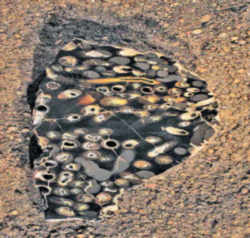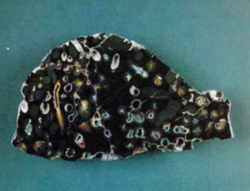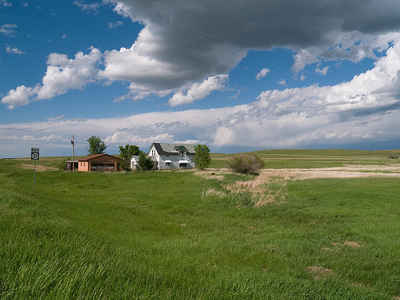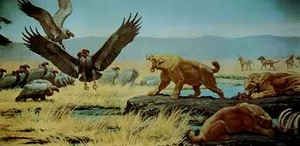North Dakota State Fossil
Teredo Petrified Wood

Adopted in 1967.
Because of the uniqueness of this petrified wood, and its popularity with collectors, the state legislature named it the state fossil in 1967, making North Dakota one of the first states to designate an official fossil. Also, North Dakota was not represented in the Smithsonian Institution's mineral collection. Naming of the Teredo petrified wood as the state fossil remedied that situation and promoted the fossil to tourists, geologists, and rockhounds.
North Dakota State Fossil: Teredo Petrified Wood

North Dakota's Paleocene seas left a layer of rocks called the Cannonball formation, which is best exposed in the Bismarck-Mandan area and southwest of these two cities. This is the best place to find North Dakots's state fossil, teredo petrified wood. That's the name given to wood that was bored by "shipworms" some sixty million years ago during the Paleocene Epoch.
North Dakota's state fossil is a peculiar type of petrified wood, called Teredo petrified wood. This wood bears the boreholes of shipworms, genus
Teredo, hence its name. Shipworms are actually mollusks, related to clams. The Teredo was a worm-shaped mollusk related to clams, mussels, and oysters.
It burrowed its way through sequoias and other trees growing near warm-water swamps in North Dakota 60 to 80 million years ago in the Paleocene Epoch.
North Dakota was partially covered by the last seaway to invade North America, the Cannonball Sea. The swamps and lowlands bordering this sea
- not too different from Florida today - were home to enormous crocodiles and giant predatory birds. The marine fauna includes bony fish and sharks,
crabs, lobsters, snails, and clams. Trees that washed into the sea were frequently attacked by shipworms before they were fossilized, leaving them
riddled with holes. As the trees in the mineral rich water petrified, some of the wood was replaced by silica and quartz, thereby preserving evidence
of the Teredo. This wood belongs to a variety of species, including bald cypress, ginkgo, redwood, and magnolia trees.Teredo petrified wood is one
of the most common North Dakota fossils and is known almost exclusively from the Cannonball Formation in Morton County, North Dakota. North Dakota
was not represented in the Smithsonian Institution's mineral collection. Naming of the Teredo petrified wood as the state fossil remedied that situation
and promoted the fossil to tourists, geologists, and rockhounds.
At the front end of a shipworm's long, worm-like body are two hard shells. Finely toothed ridges on these shells rasp wood as the shells are rocked
back and forth. Between the shells is a "foot" that acts as a suction disc. As the animal rasps, the disc is adjusted to slowly turn its body, resulting
in a circular hole. A shipworm lines its new home with material that hardens into a protective limy tube.
A shipworm seals the entrance to its new home with two hard, paddle-like structures at the rear end of its body called pallets. Two tubes or siphons
between the pallets draw in and expel water containing food.
Teredo petrified wood is one of the most common North Dakota fossils and is known almost exclusively from the Cannonball Formation, and the best collecting sites are in the south-central portion of the state. Collectors frequently polish the wood and make it into bookends and paperweights.
The North Dakota Century Code
The law designating teredo petrified wood as the official North Dakota state fossil is found in the North Dakota Century Code, Title 54, Chapter 54-02, Section 54-02-08.
Title 54. State Government.
CHAPTER 54-02. STATE EMBLEMS, SYMBOLS, AND AWARDS.
SECTION 54-02-08
54-02-08. State fossil - Teredo petrified wood. The teredo petrified wood is the official fossil of the state of North Dakota.

Some states that lack a "state fossil" have nevertheless singled out a fossil for formal designation such as a state dinosaur, rock, gem or stone.







